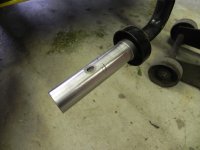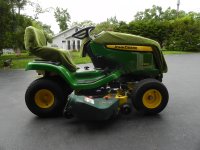P901
Member
A post script.
While the transmission work was going on with the machine up on the lift we fabricated
a set of stainless steel spindles to allow the installation of a pair of X485 front wheels, (Craiglist 75$)
Photos, stainless steel spindles, wheels installed.
Made a tire pressure gauge using a WIKA liquid filled gauge/pipe nipple/tire chuck to allow accurate pressure measurements
down into the single digits. (WIKA liquid filled gauges 0-30psi range on Ebay, ~20$)
The factory manual recommends 10psi but the machine rides much better and is much easier on the grass with 5psi.
Such low pressures can only be registered with an accurate gauge.
It was apparent while experimenting with the tire pressure, by visual indication that while on a hard flat surface the tire contact
area increased to the full width of the tread at the reduced pressure. With the ten pound setting the center of the tire was in contact
with the hard surface.
It may be realized that the recommended pressure which creates the reduced contact area places an increased point load on the turf.
andrew

While the transmission work was going on with the machine up on the lift we fabricated
a set of stainless steel spindles to allow the installation of a pair of X485 front wheels, (Craiglist 75$)
Photos, stainless steel spindles, wheels installed.
Made a tire pressure gauge using a WIKA liquid filled gauge/pipe nipple/tire chuck to allow accurate pressure measurements
down into the single digits. (WIKA liquid filled gauges 0-30psi range on Ebay, ~20$)
The factory manual recommends 10psi but the machine rides much better and is much easier on the grass with 5psi.
Such low pressures can only be registered with an accurate gauge.
It was apparent while experimenting with the tire pressure, by visual indication that while on a hard flat surface the tire contact
area increased to the full width of the tread at the reduced pressure. With the ten pound setting the center of the tire was in contact
with the hard surface.
It may be realized that the recommended pressure which creates the reduced contact area places an increased point load on the turf.
andrew


